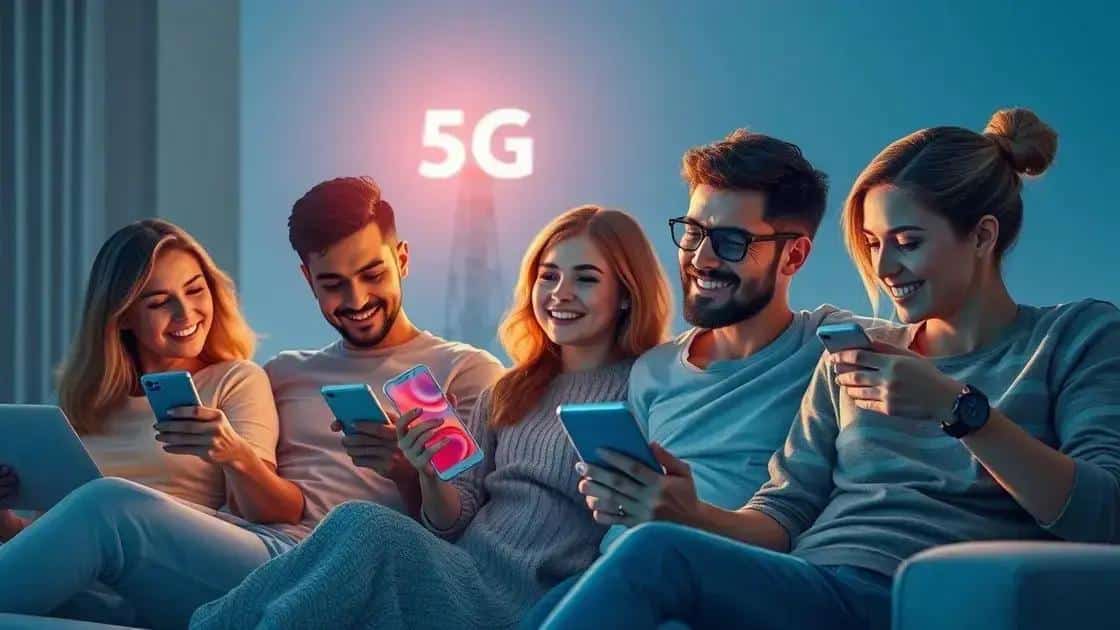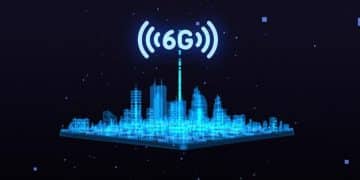5G consumer adoption is transforming digital experiences

5G consumer adoption is revolutionizing digital connectivity by providing faster speeds, enhanced device connectivity, and enabling advanced applications in various sectors, despite facing challenges like infrastructure requirements and device compatibility.
When we talk about 5G consumer adoption, we’re diving into a pivotal shift in how we connect. But have you ever wondered how this new technology will change our daily lives? Let’s explore its potential.
Understanding 5G technology
To truly grasp the impact of 5G technology, we must first understand what it is. 5G stands for the fifth generation of mobile networks, promising faster speeds, lower latency, and improved connectivity.
What Makes 5G Different?
Compared to its predecessors, 5G offers significant advancements. It’s designed to handle a much larger number of connections, which makes it ideal for our increasingly connected world. With 5G, devices can communicate more efficiently, creating a seamless experience for users.
Benefits of 5G Technology
- Faster download and upload speeds
- Reduced latency for real-time communication
- Enhanced connectivity for more devices
- Opportunities for new technologies such as IoT
Moreover, the low latency of 5G enables innovative applications like augmented reality and remote healthcare. For instance, doctors can perform surgeries in real-time from thousands of miles away, thanks to the speed and reliability of this new network.
5G technology is paving the way for advancements in smart cities, where devices communicate with each other to improve efficiency and sustainability. Consider traffic lights that adapt to real-time traffic conditions or waste management systems that alert services when bins are full. All of this is now possible because of 5G.
As we explore the realm of 5G, it’s clear that its implementation will not just enhance existing technology but will also create entirely new possibilities. The potential applications are vast, and as consumers begin to adopt these advancements, we can expect to see a rapidly evolving digital landscape.
Key benefits of 5G for consumers

The rollout of 5G networks brings exciting advantages for consumers. With improved speed and connection reliability, the way we use mobile devices is changing significantly. Not only does 5G enhance existing technologies, but it also opens doors to new experiences.
Speed Improvements
One of the most noticeable benefits of 5G is its speed. Downloads and uploads occur much faster, significantly reducing wait times. For instance, streaming high-quality video or downloading large files can be done in seconds instead of minutes.
Improved Connectivity
5G can connect a greater number of devices simultaneously. This ability is key as we move towards a more connected world, where smart home devices and IoT gadgets become commonplace. More devices online mean better integration into our daily lives.
- Enhanced video conferencing with no lag
- Seamless gaming experiences with lower latency
- Real-time data transfer for smart devices
- Access to advanced applications like AR and VR
As restaurants, homes, and cities become increasingly connected, 5G will enable smart technology to thrive. Imagine your refrigerator notifying you when groceries are low or traffic lights adjusting based on real-time traffic.
Moreover, 5G supports innovations in areas such as telemedicine, where doctors can provide remote consultations with low latency. This change can dramatically increase healthcare accessibility, especially in rural areas.
The advantages of 5G are clear and far-reaching. As consumers adopt this technology, they will enjoy faster, more reliable connections that empower them in countless ways. This shift is just the beginning of a new digital age where technology and everyday life merge seamlessly.
Challenges in 5G consumer adoption
Despite the exciting promise of 5G, there are significant challenges in its consumer adoption. Understanding these obstacles can help us better prepare for the widespread implementation of this technology.
Infrastructure Limitations
One major challenge is the need for extensive infrastructure upgrades. Many areas lack 5G towers and the necessary technology. This limitation means that even if devices support 5G, users may not have access in their region.
Device Compatibility
Another issue involves device compatibility. Not all smartphones or devices are equipped to handle 5G. This situation creates confusion among consumers and may slow the transition as people wait for new devices to become available.
- Consumers need to upgrade their devices
- Higher costs for 5G-enabled products
- Potential learning curve for new features
Additionally, the cost of upgrading infrastructure can be high for service providers. They may hesitate to invest without guaranteed consumer demand. This hesitation can delay the rollout of 5G networks, leaving many potential users in the dark.
Concerns related to health and safety also play a role. As 5G uses higher frequency waves, some are apprehensive about their potential effects on health. This worry can lead to resistance from communities and delays in deployment.
Finally, there’s the challenge of affordability. While 5G promises many benefits, the associated costs may be prohibitive for some consumers. Ensuring that 5G remains accessible to all is vital for its success and widespread adoption.
Future trends in digital connectivity

The future of digital connectivity is exciting, especially with the advent of 5G. As more consumers adopt this technology, we can look forward to transformative trends that will shape how we live and work.
Expansion of IoT Devices
One significant trend is the expansion of Internet of Things (IoT) devices. With 5G, more devices will be able to connect seamlessly. This connectivity will enable smarter homes, where everything from refrigerators to thermostats can communicate and function intelligently.
Enhanced Mobile Experiences
A major benefit of 5G is the enhancement of mobile experiences. Expect faster streaming, better gaming, and improved video calls. As data speeds increase, mobile applications will become more responsive and interactive.
- Increased use of augmented reality (AR) applications
- Real-time gaming experiences without lag
- High-definition live streaming capability
Moreover, industries such as healthcare will greatly benefit. With 5G, doctors can use remote surgery robots, monitoring patient health in real-time. This advancement can save lives and reduce the need for in-person visits.
Another critical trend is the development of smart cities. With interconnected devices, cities can optimize traffic management, energy usage, and public safety. Lights will adjust based on traffic flow, and waste collection can be streamlined through smart sensors.
Furthermore, 5G will promote advances in artificial intelligence. As machines can communicate and share data faster, AI algorithms will process information more efficiently. This enhancement can lead to smarter services and improved customer experiences.
The future is bright with 5G technology paving the way for exciting changes in how we connect. As we embrace this new era of digital connectivity, we will see improvements in speed, capacity, and overall user experience. From smarter homes to advanced healthcare solutions, the benefits of 5G will be vast. However, to fully harness its potential, we must overcome challenges like infrastructure requirements and device compatibility. Staying informed and prepared will allow us to enjoy a seamless and connected future ahead.
FAQ – Frequently Asked Questions about 5G Technology
What are the main benefits of 5G technology for consumers?
5G offers faster speeds, lower latency, and improved connectivity, enhancing mobile experiences and enabling new technologies like smart homes.
How does 5G impact the Internet of Things (IoT)?
With 5G, more IoT devices can connect seamlessly, leading to smarter homes and cities where devices communicate efficiently.
What challenges does 5G face in consumer adoption?
Challenges include the need for infrastructure upgrades, device compatibility, costs, and public health concerns.
How will 5G change industries like healthcare?
5G will enable remote surgeries and real-time patient monitoring, increasing accessibility and improving healthcare outcomes.





